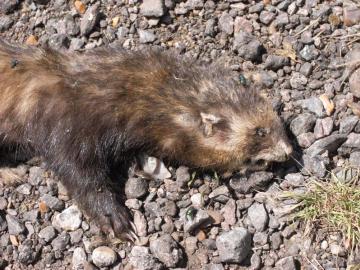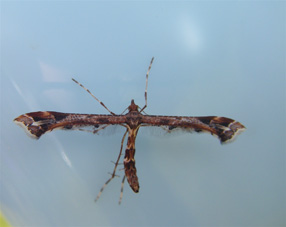I think bee orchids are pretty local, but not especially rare in the county. However they are always very nice plants to find, and worthy of conservation. It sounds to me as though your management is just about exactly what is needed, not just for plants like bee orchids but also lots of other things as well, including my own speciality interest, insects and other invertebrates. Perhaps a botanist can comment?
Your Forum
The weblog below is for naturalists to use to report interesting sightings, ask questions, report on field meetings and generally post pictures and any information or questions generally relevant in some way to the wildlife and geology of Essex. You will need to register and be logged-on to post to the forum, and you need to upload pictures first, for use in posts. Find out more
|
Fri 26th June 2009 19:55 by Jane Baxter bee orchids
Am i right to get excited i have found bee orchids growing in the field where i graze my horse.The field is about three acres near Woodham ferrers village up the hill from south woodham. I use electric fencing to limit grazing to a small area during spring and summer and then let my horse eat it off in the winter. How widespread is it in essex ? and should i do anything to protect it? Fri 26th June 2009 10:00 by Peter Harvey
Dear David
You ask a good question about Dolichovespula media - at the time the Essex Red Data List was first put together, this wasp was still rare in the county with only very few records. Although it had been spreading in southern England for some years it was considered to still warrant Essex listing (and indeed is still officially Nationally Scarce (Notable A). I have now removed it from the ERD List to reflect its present distribution and status in the county. Thu 25th June 2009 23:56 by David Corke Polecat or ferret? Thu 25th June 2009 23:38 by David Corke Dolichovespula media
I have a (small football-sized) nest of this species doing well suspended in a large shrub in my garden (Tye Green, Wimbish TL591354). The workers enter my moth trap in quite large numbers.
From the EFC distribution map it looks like this is the most northerly Essex record for this species. Why is it ERDB listed? Mon 22nd June 2009 16:41 by Grant Maton Five Spot Burnet Zygaena lonicerae
Thanks Peter
As somebody who is not an expert in all the species of Five Spot Burnet I
appreciate now knowing what I was looking at. I was just impressed with the
numbers I was seeing! My son actually found a Lime Hawk Moth the same
weekend, so we are really happy. We are also taking part this week in the
Moth count for Butterfly Conservation.
Kind regards
Grant
Grant Maton Corporate Communications Officer Essex Wildlife Trust 07887 763 678 ewt@gmaton.com Sun 21st June 2009 18:45 by Peter Harvey
This will be Narrow-bordered Five-spot Burnet Zygaena lonicerae rather than Five spot Burnet, which is extinct in Essex (see Brian Goodey's 2004 Moths of Essex). In grasslands supporting good quantities of its food plants (e.g. Meadow Vetchling, clovers) and which are left uncut during its development and pupation, then it can certainly occur in good numbers - but anywhere in Essex supporting large populations in our modern degraded landscape is good! Sat 20th June 2009 18:08 by Grant Maton Five Spot Burnet Zygaena trifolii
I have just counted over 200 Five Spot Burnet moths on Thistles at Chafford Gorge Nature Reserve in West Thurrock Essex. In fact this was only a small percentage as I ran out of time! Is this an unusual sighting in Essex and at that density? There were also Cinnabar Moths as well.
Grant Maton Corporate Communications Officer Essex Wildlife Trust 07887 763 678 ewt@gmaton.com Essex Wildlife Trust A private company limited by guarantee without share capital Company Number: 638666 Registered Office Address: The Joan Elliot Visitor Centre, Abbotts Hall Farm, Gt. Wigborough, Colchester, Essex CO5 7RZ Registered Charity Number: 210065 VAT Registered Number: 623 0920 72 Thu 18th June 2009 13:53 by Jan Jordan Teasels (Dipsacus fullonum)
Good homes needed for teasel plants
We have an over-abundance of healthy teasel plants which came up in our vegetable garden again this year. I have dug up some of the young plants which will flower next year (July-August) - about 100 plants & I am reluctant to destroy them - they transplant quite readily and do particularly well if they have adequate water. The teasel is a beautifully structured attractive plant growing to a height of 2m (6 ft) or over and is biennial; the long spiny flowerheads with mauve flowers attract bees and later seed-eating birds (such as goldfinches) that delight in pulling out the seeds. If anyone interested please contact me by email: jajordan_54@yahoo.co.uk.
Jan Jordan (and partner Livio) Thu 18th June 2009 12:45 by Jan Jordan Large Tortoiseshell butterfly (Nymphalis polychloros)
Before anyone becomes too excited, this was not a positive ID.
A possible sighting 14/6/09 in lower field, beside path, the Weald, Brentwood, but unable to positively ID because of distance. I will return ASAP and continue search. Thu 18th June 2009 12:39 by Jan Jordan Small Tortoiseshell butterfly (Aglais urticae)
One sighted 27/2/09 in churchyard, Brentwood, central body colouring bluish, not brown - possibly a female? Another sighting 18/4/09, one only, Stoke Saint Cross close to Dunston Hall, Norwich - local sub-species, brown central pattern (as usually depicted). Thu 18th June 2009 12:28 by Jan Jordan Hummingbird Hawk-moth (Macroglossum stellatarum)
One brief sighting 17/6/09 in back garden Chase Road Brentwood - adult feeding on flowering sage (salvia sp.) - flew off quickly into neighbour's back garden and began feeding on flowering mock orange shrub. Thu 18th June 2009 12:11 by Jan Jordan Cinnabar moth (Tyria jacobaeae)
A few adults sighted 13/6/09 Ellen's Wood, Lt. Warley. A few adults sighted 14/6/09 on the Weald, Brentwood. Hundreds of their larvae seen on Ragwort/Senecio sp. Ellen's Wood 17/7/08. Sat 13th June 2009 09:33 by Martyn Everett Amblyptilia acanthadactyla? Sat 6th June 2009 07:33 by Peter Harvey
Not my group, but certainly seems a good find! Excellent. Wed 3rd June 2009 02:33 by Ben Sale Brown Oak Tortrix (Archips crataegana)
Having collected a few leaves from Hatfield Forest I awaited the emergence of the pupa that I found.
2 turned out to be the very handsome Green Oak Tortrix (Tortrix viridana) http://bensale-essexmoths.blogspot.com/2009/05/in-life-of-gren-oak-tortrix.html
1 turned out to be a Brown Oak Tortrix (Archips crataegana) http://bensale-essexmoths.blogspot.com/2009/06/day-in-life-of-brown-oak-tortrix.html which I understand is quite scarce. Hope everybody else is experiencing great Moth-trapping at the moment! Regards Ben (Bennyboymothman) |
Archives: May 2020Aug 2019 Jan 2019 Sep 2018 Jul 2016 Oct 2015 Jul 2015 May 2015 Apr 2015 Mar 2015 Feb 2015 Jan 2015 Dec 2014 Oct 2014 Sep 2014 Aug 2014 Jul 2014 May 2014 Apr 2014 Mar 2014 Feb 2014 Jan 2014 Dec 2013 Nov 2013 Sep 2013 Aug 2013 Jul 2013 Jun 2013 May 2013 Apr 2013 Mar 2013 Feb 2013 Jan 2013 Dec 2012 Nov 2012 Oct 2012 Sep 2012 Aug 2012 Jul 2012 Jun 2012 May 2012 Apr 2012 Mar 2012 Feb 2012 Jan 2012 Dec 2011 Nov 2011 Oct 2011 Sep 2011 Aug 2011 Jul 2011 Jun 2011 May 2011 Apr 2011 Mar 2011 Feb 2011 Jan 2011 Dec 2010 Nov 2010 Oct 2010 Sep 2010 Aug 2010 Jul 2010 Jun 2010 May 2010 Apr 2010 Mar 2010 Feb 2010 Nov 2009 Oct 2009 Aug 2009 Jul 2009 Jun 2009 May 2009 Apr 2009 Mar 2009 Feb 2009 Jan 2009 Nov 2008 Oct 2008 Sep 2008 Aug 2008 Jul 2008 Jun 2008 May 2008 Apr 2008 Mar 2008 Feb 2008 Jan 2008 Dec 2007 Nov 2007 current posts |



















